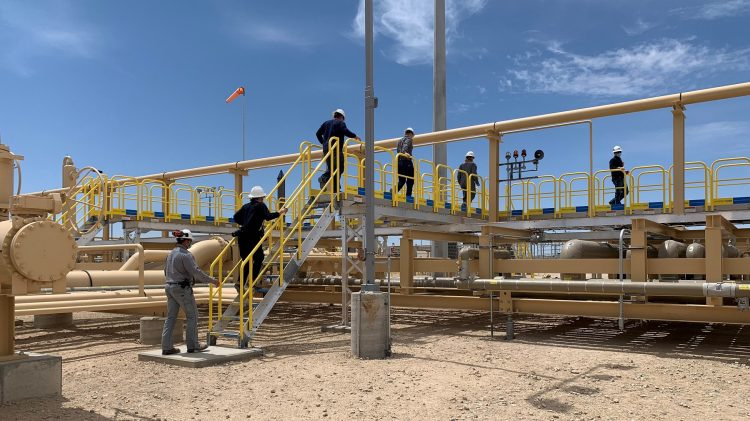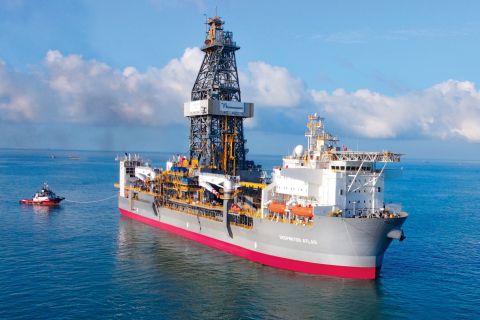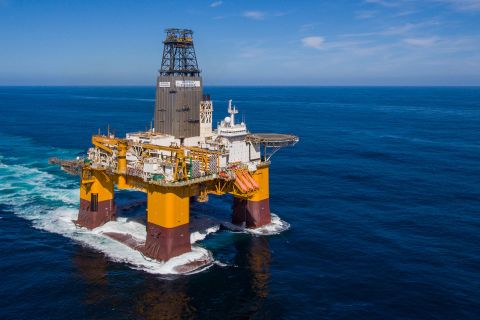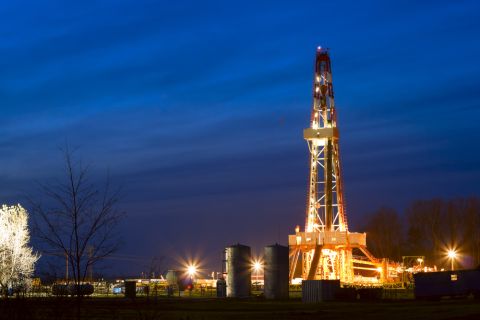Presented by:
The push to hit net-zero goals is transforming the energy landscape as U.S. shale players look to operate more sustainably.
Reducing emissions has taken a pivotal role in operators’ strategies to incorporate low-carbon solutions. The Permian Basin is no exception as producers seek to work in cleaner and more efficient ways to produce affordable and reliant energy. The pathways are plentiful, and there doesn’t appear to be a common route. However, partnerships are prevalent as companies come together to slow climate change.
“In the Permian Basin, I think what you have is the continuation of an improved ESG process. They’re absolutely focused on getting their carbon emissions down and reducing flaring, reducing methane,” Dan Pickering, founder and chief investment officer for Pickering Energy Partners, told Hart Energy. “Then, there’s the electrification element, which helps get emissions down, and that’s across everything from power to oilfield service equipment.”
Along with that comes investments in solar and wind energy as well as battery technology as shale players look to power well sites and large energy companies look to diversify their assets. Some are also diving deep into carbon capture, while others are making plans to become part of the hydrogen economy.
“We’re seeing the incumbent energy space embrace decarbonization more aggressively.”—Dan Pickering, Pickering Energy Partners
Like other experts, Pickering cautions that the energy transition will take time, and oil and gas will still be needed. Plus, there are profits and access to capital to think about.
“We’ve seen the traditional energy business go from resisting and viewing the energy transition as a competitive negative to now saying, ‘It’s coming. Where can we participate? What are the opportunities? How can we make money?’” he said. “We’re seeing the incumbent energy space embrace decarbonization more aggressively.”
Evolving landscape
As the largest oil field in the U.S., the Permian Basin produces more than 5.4 MMbbl/d of oil along with more than 20.7 Bcf/d of natural gas, according to estimates from the U.S. Energy Information Administration.
Wind turbines and solar panels increasingly are placed among the oil and gas rigs as operators turn to renewables to help power parts of their operations.
“What the Permian shows is really underscoring the underlying theme that energy is an ‘and’ not an ‘or,’” said Greg Matlock, Americas energy transition and renewable energy leader for EY. “This is a strategic energy producing area. The focus is on production to meet strategic needs and how we can operate in cleaner, more efficient manners.”
There is also focus on improving carbon intensity and decarbonizing.
Companies are making net zero and other ambitions publicly known, communicating plans for specific assets, added Pat Jelinek, Americas oil and gas leader for EY.
“You’re starting to see a lot more innovation and focus around methane reductions, a lot more transparency on how it’s measured, reported and ultimately contained, and a lot of investment around carbon capture,” Jelinek said.
Also evident is more discussion on feasibility, what it takes to scale and required infrastructure to get products to market, he added.
There are no specific pathways that all shale players appear to be taking to lower emissions and reach net-zero goals. However, “without question, you’re starting to see a lot of collaboration through the suppliers,” Jelinek said. “They’d already been advancing things like automation in the field, but now you are starting to see electrification. You’re starting to see a lot more integrated planning with some of the drillers and ultimately, the equipment manufacturers that support the drillers as well.”
Conversations are taking place on optimized scheduling, management of gensets in the field, how to best decrease carbon intensity of basic operations as well as through capture and other adjacencies.
“It’s definitely not a one size fits all [approach],” Matlock added. “I think the recent past has kind of opened up a full review of the entire value chain where each company is looking for areas of improvement both operational and economic. There are ways to achieve both. It’s fairly bespoke on a company-by-company basis.”
Results of a study released this year by analysts from the Joint Institute for Strategic Energy Analysis (JISEA) and the National Renewable Energy Laboratory (NREL) revealed that integrating clean energy into oil and gas operations could reduce emissions and maximize higher-value use of produced hydrocarbons.
The study evaluated clean energy technologies for an oil field in the Delaware Basin and aimed to determine which options were economically attractive. Results included that smaller renewable energy technologies—such as those generating 5% of a site’s load (i.e. an 8-kW PV system)—could be effective in lowering grid purchases. However, larger systems generating at least half of the site’s load could add costs, though there are environmental benefits.
The study also pointed out the advantages of microgrids, highlighting their ability to overcome electrical outages and operate independently from the electric utility, when needed. It noted microgrids’ potential to “create higher value streams from [distributed energy resources] through an optimized dispatch strategy and the deployment of ancillary services.”

Eyeing trends
Electrification is becoming more common in the Permian, helping to not only lower carbon intensity of operations but also find uses for some offtake, Jelinek said, noting it’s a trend that EY believes will continue.
BP, which grew its Permian Basin presence with its acquisition of BHP’s shale assets in 2018, is among the companies stepping up electrification efforts in the basin. The company in April 2021 commissioned an automated, electrified central oil, gas and water handling facility called Grand Slam facility near Orla, Texas. The facility uses a separation and compression system that recovers gas that would have otherwise been flared at traditional well sites.
In addition to lowering operational emissions and improving efficiency, the project increased gas production, creating another commercialization opportunity.
The intent is that the facility, alongside other investments in electric infrastructure, will lead to more than 95% of the company’s Permian-operated wells becoming electrified by 2023, the company has said. This marked the largest infrastructure project to date for BP’s onshore business.
“What the Permian shows is really underscoring the underlying theme that energy is an ‘and’ not an ‘or.’”—Greg Matlock, EY
More companies are also pursuing carbon capture projects, especially as incentives in the Inflation Reduction Act (IRA) make projects economic.
“It’s really an area where oil and gas companies can take historic knowledge bases and skill sets from the upstream through midstream, capturing and moving molecules downhole, … and achieve net zero goals,” Matlock said. “You see quite a number of announcements in the Permian in particular around enhanced oil and natural gas recovery, permanent sequestration. I do expect that to be more mainstream, especially with the positive economic benefits of the Inflation Reduction Act.”
The EPA approved San Antonio-based Stakeholder Midstream’s monitoring, reporting and verification plan for its Permian Basin carbon capture project, the company said in September. The project calls for permanently storing the CO₂ in the Devonian formation more than 2 miles below ground and 10,000 ft below the water table.
“We believe that by offering these services to third parties, including other gas processing plants in the Permian region and beyond, we can provide an environmentally responsible solution for CO₂ emitters to reduce the carbon intensity of their oil and gas operations and to meet their ESG goals,” Stakeholder Midstream chief commercial officer Brett Baker said. “Our vision is to become one of the leading carbon solutions providers in the United States by helping producers and like-minded midstream companies across multiple basins decarbonize their operations.”
Companies are trying to balance energy security and energy transition now, Jelinek said, noting CCUS is a proven technology that can be put to use today.
Partnering with renewables
Permian players are also partnering with renewable companies, sourcing energy for drilling operations from wind and solar companies.
“You’re absolutely seeing collaboration and discussions between core renewable companies and oil and gas companies because either generally can’t do what the other party is doing,” Matlock said. “These are the hyper-technical ways of producing energy.”
In recent months, companies active in the Permian and other U.S. shale plays have formed partnerships in areas such as hydrogen, geothermal and battery technology.
Independent oil producer ConocoPhillips Co. will provide natural gas and manage a CCS facility for a proposed U.S. hydrogen gas project to be jointly developed with Japan’s utility JERA.
Nabors Industries Ltd. has invested $7 million in Natron Energy Inc. to be used for the advanced production of Natron’s sodium-based battery technology, the company said in July.
Oilfield service company Liberty also invested in the sodium-ion battery manufacturer, looking to batteries to provide backup power for its electric frac pumps.
“You’re [also] seeing a lot of interest from the oilfield service community around geothermal because it involves a lot of the same—drilling holes in the ground,” Pickering said. “Geothermal has raised some money recently. There are several successful financings within geothermal startups.”
The only way to invest in some of these adjacencies and collaboration is to have volume, Jelinek said. Operators with higher cash flows from upstream operations and more global demand for products—given the impact of Russia’s invasion of Ukraine—are leading to more M&A activity.
“The momentum is accelerating greatly, and now with these additional incentives through IRA and various other global schemes,” he said, “you’re seeing a lot more people realize the economic viability of a longer-term basis for some of these assets.”
Still, projects need to make economic sense. The IRA is making that happen, Matlock added.
“I think longer term, you’ll see more and more pairing of renewable power with other power,” he said.
Though energy transition-related projects are not beating oil and gas projects when it comes to rates of return, costs are hopefully still on the decline curve, Pickering said.
“There are plenty of projects that look like they have economics that meet hurdle rates. I don’t think they’re as good as oil and gas, but they’re not necessarily intended to be right now,” he said. “With the support from the Inflation Reduction Act, an increasing [number] of projects can make money for investors, including the credits.”
Balancing act
Adapting to a low-carbon world won’t be a quick journey and hydrocarbons will still be needed.
“I’m hopeful that we learn from things that we’ve seen in Europe—that the faster we go, the potentially more expensive and volatile it might be,” Pickering added. “So, we’ve got to make sure that we balance these things. I think we’ll see the cycles in all of it. But I would just say we need to prepare for a 25-year process, not a two-quarter process.”
“You’re starting to see a lot more innovation and focus around methane reductions, a lot more transparency on how it’s measured, reported and ultimately contained, and a lot of investment around carbon capture.”—Pat Jelinek, EY
Companies have tighter ESG frameworks with higher standards. They also have more money than they’ve had before, so there is less need for as much external capital—though needs still exist, according to Pickering.
“These companies are funding a lot of their own initiatives and they’re not going out asking for new equity capital. They want to roll their revolvers. They want access to bank markets,” he said. “They want access to the public capital markets. But they’re not desperate anymore. So, there's a competitive tension there as well. The money is not making all the demands in this environment.”
Looking at energy security as a backdrop, Jelinek called the Permian “one of the crown jewels” where companies want to deploy capital. “So, decreasing the carbon intensity in that asset and looking for adjacencies … all go hand in hand,” he said.
Net-zero targets by 2050 will be hard to hit, Pickering added.
“We’re going to be talking about all forms of energy for quite a while and we are really lucky that the U.S. has the best of both worlds. We have an increasingly vibrant energy transition community and we’ve got an oil and gas community that is delivering pretty low-cost and secure energy. You put those two things together, and we ought to be in a pretty good spot for this next 25-year run.”
Recommended Reading
TPH: Lower 48 to Shed Rigs Through 3Q Before Gas Plays Rebound
2024-03-13 - TPH&Co. analysis shows the Permian Basin will lose rigs near term, but as activity in gassy plays ticks up later this year, the Permian may be headed towards muted activity into 2025.
Rystad: More Deepwater Wells to be Drilled in 2024
2024-02-29 - Upstream majors dive into deeper and frontier waters while exploration budgets for 2024 remain flat.
Less Heisenberg Uncertainty with Appraisal Wells
2024-03-21 - Equinor proves Heisenberg in the North Sea holds 25 MMboe to 56 MMboe, and studies are underway for a potential fast-track tieback development.
Evolution Petroleum Sees Progress on SCOOP/STACK, Chaveroo Operations
2024-03-11 - Evolution expects to participate in future development blocks, holding in aggregate over 70 additional horizontal well locations.
Comstock Continues Wildcatting, Drops Two Legacy Haynesville Rigs
2024-02-15 - The operator is dropping two of five rigs in its legacy East Texas and northwestern Louisiana play and continuing two north of Houston.







